I was at the State Fair with one of my best friends from Elementary School. We were 2,000 miles from our old school stompin’ grounds. And my buddy had been, ahem, a bit overserved.
“It feels like the first time!” he belted alongside Lou Gramm, the former lead singer of Foreigner. No longer kids, we had matured. Now we were slamming beers within sud-splashing distance of the Lou Gramm Band.
We’ll channel Lou and Foreigner today as we consider five fresh dividends. They don’t happen often but, when they do, it’s a special moment. A sign of actual corporate maturity. Management saying we’re no longer kids chasing growth, we’re going to start dishing cash to shareholders.
Big returns often follow.
Take Starbucks (SBUX), which in April 2010 paid its first dividend—a nickel-per-share payout that stunned many plain vanilla observers at the time. Responses were predictable, with headlines like “Starbucks: Slower Growth Ahead” questioning whether the company’s best years were behind it.
They weren’t, of course. Starbucks has clobbered the market ever since. But importantly, SBUX shares kept sprinting in the immediate years following the dividend increase.
Does This Look Like a Company That Ran Out of Growth Ideas?
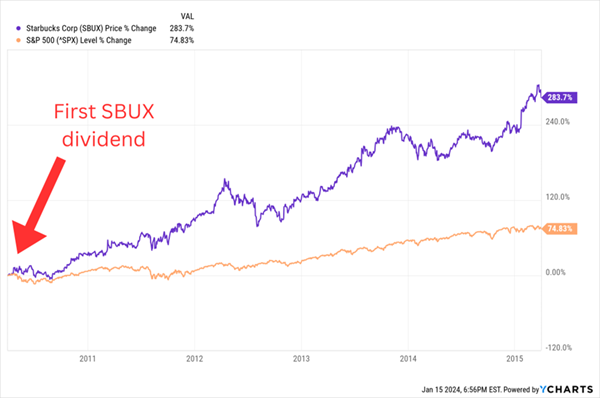
Starbucks’ dividend has exploded, too, from 5 cents per share quarterly then to 57 cents now. And if you had bought shares roughly around when SBUX kicked off its new payout, you’d be sitting on a yield on cost of more than 18%!
Life-Changing Dividend Growth for Long-Term Investors
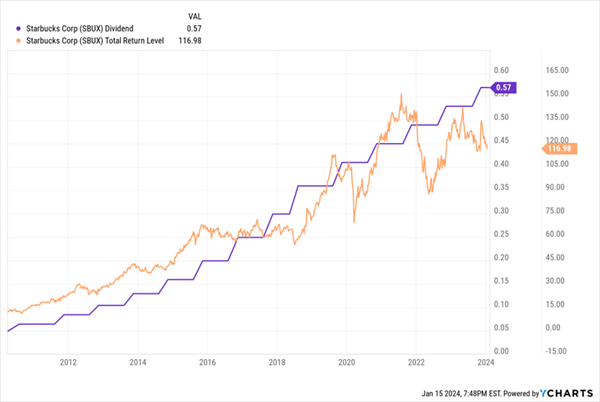
Let’s also consider chipmaker Nvidia (NVDA), which everyone knows as one of the market’s greatest growth darlings. They forget the company dishes a dividend, and has for more than a decade. This was, needless to say, a good time to buy:
It Feels Like 2,000% Returns
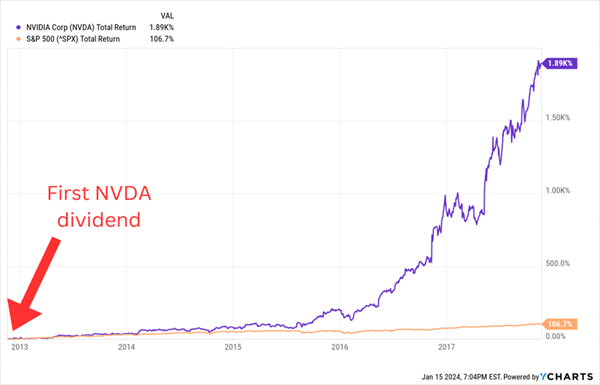
Should all new dividends be bought? Not necessarily. Let’s be calculated contrarians so that we can separate the next Foreigner from the next, well, Lou Gramm Band backup guitarist.
Endeavor Group (EDR)
Dividend Initiation Announcement: May 9, 2023
First Dividend Payment: Sept. 29, 2023
Dividend Amount: $0.06
Dividend Yield: 1.0%
Endeavor Group (EDR) is relatively new to the public markets, having hit the New York Stock Exchange in 2021, but it has roots going all the way back to 1898, when the talent agency Williams Morris Agency was formed.
Endeavor Group is an entertainment, sports and content company that either outright owns, or owns a majority stake in, Ultimate Fighting Championship, World Wrestling Entertainment, Professional Bull Rider, EuroLeague (basketball), Learfield/IMG College, and William Morris Endeavor (WME) Agency, among other brands.
Endeavor spent 2023 splashing a lot of cash—and not just on a shiny new dividend. Its more high-profile move was the $21 billion merger of UFC and WWE into a new company (TKO Group), of which Endeavor will own 51%.
In May 2023, while waiting for the UFC-WWE deal to finalize, EDR announced it planned to start up a new dividend program, with expectations of declaring its first payout sometime during the third quarter. And sure enough, at the end of August, it announced a 6-cent dividend to be paid near the end of September.
Endeavor needs something to spark its shares, which have largely languished since its 2021 offering and currently trade below their $24 IPO price. The dividend could do it—but so could an underappreciation of its wide array of assets, which are simply unlike any other publicly traded company.
Can the Dividend Kick-Start EDR Shares?
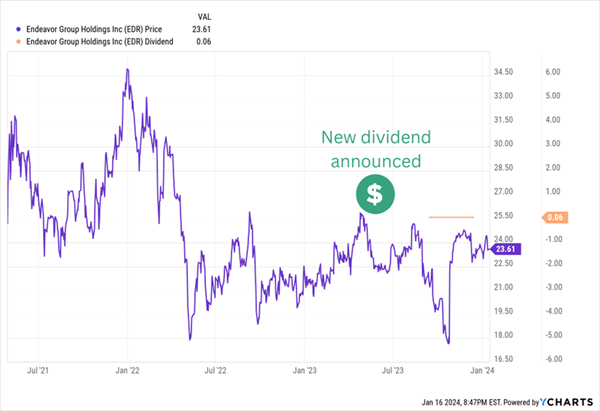
Meritage Homes (MTH)
Dividend Initiation Announcement: Feb. 16, 2023
First Dividend Payment: March 31, 2023
Dividend Amount: $0.27
Dividend Yield: 0.6%
Meritage Homes (MTH) is a mid-cap homebuilder that builds single-family attached and detached homes for first-time and first move-up buyers, primarily across the southern U.S., from California to the Carolinas. And like many homebuilders, it also provides mortgage, title, title insurance, and other housing-finance products to buyers of its homes.
Also like many homebuilders, MTH has had a lively couple of years.
The Federal Reserve’s rate-hike spree, which started in 2022, sparked a good nine months or so of decline in homebuilders. But at a certain point, higher rates didn’t just keep buyers out of the market—they kept sellers out, too, which pinched existing-home supply and pushed buyers into new homes. That started a resurgence in homebuilders like Meritage, and signs that the Fed has exhausted its rate-hiking has continued the celebration. BofA says that for every 25 bps that the mortgage rate declines (as long as it’s under 7%), more than a million households are priced back into the housing market.
MTH shares have risen amid this anticipation, as well as on its own Street-beating results. Further whipping up the bull crowd was its February 2023 announcement of a new dividend program, starting with a 27-cent distribution paid out in March. And if these housing tailwinds continue blowing, as many expect, this could mark the beginning of a cycle where MTH shares and the company’s dividend pull one another higher.
The Dividend Magnet Has Already Activated
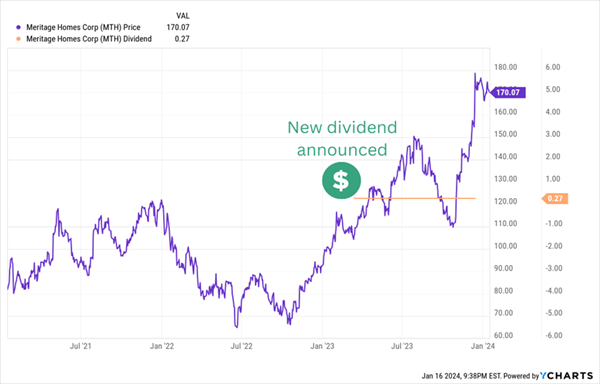
Phinia (PHIN)
Dividend Initiation Announcement: Aug. 31, 2023
First Dividend Payment: Sept. 22, 2023
Dividend Amount: $0.25
Dividend Yield: 3.5%
A common thread among many payout initiators (of 2023 and most years): spinoffs from companies with dividend programs that, a month or two after being set loose, kick off their own dividend programs.
I don’t think many of these are noteworthy—this kind of dividend “continuation” is largely expected—but one stands out.
Phinia (PHIN) develops and makes a wide variety of products meant to optimize performance, increase efficiency, and reduce emissions in commercial and light vehicles, as well as for industrial applications. Its products include fuel injection systems, engine control modules, canisters, sensors, starters, alternators, test equipment, vehicle diagnostics solutions, and much more.
Phinia was spun off from BorgWarner (BWA), a diversified vehicle component manufacturer, to allow the companies to focus on their respective areas of the market. Specifically, BorgWarner is gravitating more toward electric vehicles, while Phinia predominantly deals with internal combustion engines (ICEs). The question going forward for investors is whether there’s any future for Phinia—and the answer isn’t as clear as it seems. While EVs very much might be the standard down the road, myriad hurdles remain, and adoption isn’t a given—falling EV demand has forced General Motors (GM) and Ford (F), among others, to rein in their EV aspirations of late.
Phinia shares quickly cooled off and are trading 20% lower than they did immediately after the spinoff. But the dividend might be starting to convince shareholders that all’s not so bad—in part because it’s generous for a “new” payout, at well more than 3%.
PHIN Management Hopes Cash Will Ignite Its Shares
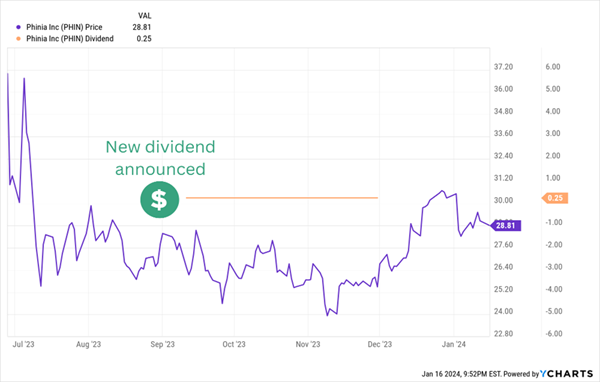
HealthStream (HSTM)
Dividend Initiation Announcement: Feb. 20, 2023
First Dividend Payment: April 28, 2023
Dividend Amount: $0.025
Dividend Yield: 0.4%
HealthStream (HSTM) is a health-tech company that has been around since 1990 and publicly traded since 2000, but has avoided investors’ radars for all but a few years in the early 2010s.
HealthStream provides a number of healthcare solutions for workforce development, nurse and staff scheduling, clinical education, credentialing, performance assessment, and more. Its technologies are used by private, not-for-profit, and government entities, as well as pharmaceutical and medical device companies.
Like with many other IT firms, HealthStream has identified an opportunity to use software-as-a-service (SaaS) to drive recurring revenues. HSTM has been integrating its core functions into a unified platform, dubbed hStream, which it believes will be more useful to its clients and, more important for the bottom line, drive both upselling and higher retention.
Of course, the natural goal is to drive the first meaningful explosion in HSTM shares in more than a decade.
But Maybe a Dividend Can Spark the Stock, Too
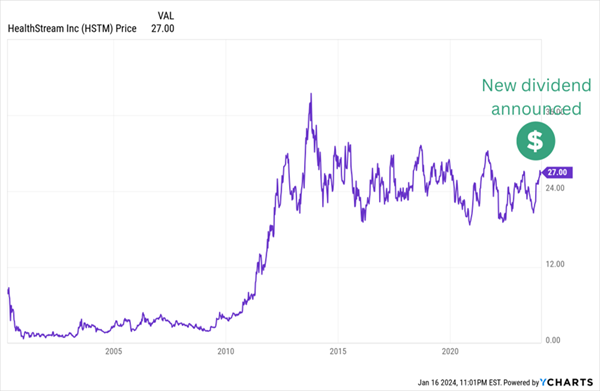
In February 2023, the company announced that it would start paying a quarterly distribution in April—a meager sum that comes out to a sub-1% yield at current prices. It’s also a mere 10% of last year’s earnings—a payout ratio that implies all sorts of room for expansion should its hStream platform bear fruit.
T-Mobile US (TMUS)
Dividend Initiation Announcement: Sept. 25, 2023
First Dividend Payment: Dec. 15, 2023
Dividend Amount: $0.65
Dividend Yield: 1.6%
One of the final new dividends paid in 2023 came from T-Mobile US (TMUS), who officially took U.S. telecom from a “Big Two” of AT&T (T) and Verizon (VZ) to a “Big Three” with its 2020 merger with Sprint.
But was it really an American telecom giant without throwing some of its cash at shareholders?
I joke, but I do wonder whether T-Mobile is a dividend magnet situation—or what investors typically fear when a company with an explosive stock starts diverting money from growth to a dividend payment.
Does T-Mobile Need a Dividend Magnet?
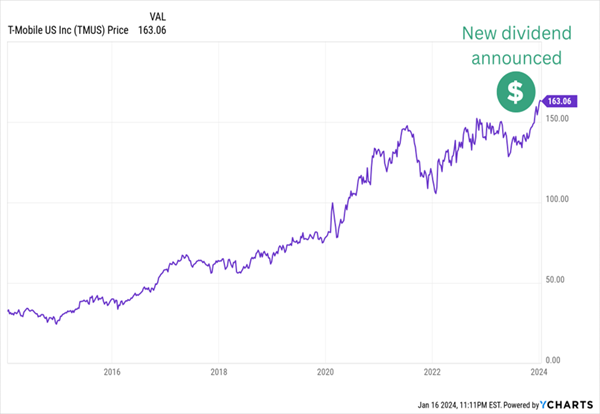
To be clear: T-Mobile seems particularly poised to keep stealing its rivals’ lunch. Its subscriber growth continues to impress, especially in rural and enterprise areas, and its 5G network is actually ahead of AT&T and Verizon. Read differently: TMUS’s growth stage isn’t necessarily done yet.
5 Explosive “Dividend Magnet” Picks That Could Turbo-Charge Your Portfolio Yield
But T-Mobile is ultimately doing business in a completely saturated U.S. market. That means there are no easy wins to be claimed from fresh addressable market—TMUS’s only path to growth is clawing away business from America’s established telecom titans.
That’s OK. T-Mobile US is hardly a secret—it’s a longtime performer whose dividend might grow, but whose growth is largely baked in.
But the “Dividend Magnet” strategy is still a formula for success—one that can guide you to truly potent dividend growers with hidden advantages that most first-level investors look right through.
But I’m staring directly at 5 such stocks right now. And each one boasts a soaring dividend payout that’s yanking its share prices higher—a recipe for both exciting share-price growth and retirement-altering yields-on-cost.
